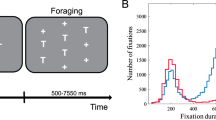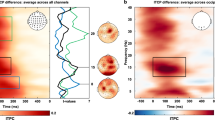Abstract
In studies of the neural mechanisms giving rise to behaviour, changes in the neural and behavioural responses produced by a given stimulus have been widely reported. This ‘gain control’ can boost the responses to sensory inputs that are particularly relevant1,2,3,4, select among reflexes for execution by motoneurons5,6 or emphasize specific movement targets7. Gain control is also an integral part of the smooth-pursuit eye movement system8,9,10,11,12,13. One signature of gain control is that a brief perturbation of a stationary target during fixation causes tiny eye movements, whereas the same perturbation of a moving target during the active state of accurate pursuit causes large responses9. Here we show that electrical stimulation of the smooth-pursuit eye movement region in the arcuate sulcus of the frontal lobe (‘the frontal pursuit area’, FPA) mimics the active state of pursuit. Such stimulation enhances the response to a brief perturbation of target motion, regardless of the direction of motion. We postulate that the FPA sets the gain of pursuit, thereby participating in target selection for pursuit.
This is a preview of subscription content, access via your institution
Access options
Subscribe to this journal
Receive 51 print issues and online access
$199.00 per year
only $3.90 per issue
Buy this article
- Purchase on Springer Link
- Instant access to full article PDF
Prices may be subject to local taxes which are calculated during checkout



Similar content being viewed by others
References
Desimone, R. & Duncan, J. Neural mechanisms of selective visual attention. Annu. Rev. Neurosci. 18, 193– 222 (1995).
Maunsell, J. H. The brain's visual world: representation of visual targets in cerebral cortex. Science 270, 764–769 (1995).
Treue, S. & Martinez Trujillo, J. C. Feature-based attention influences motion processing gain in macaque visual cortex. Nature 399, 575–579 ( 1999).
Posner, M. I. Attention: the mechanisms of consciousness. Proc. Natl Acad. Sci. USA 91, 7398–7403 ( 1994).
Pearson, K. G. Proprioceptive regulation of locomotion. Curr. Opin. Neurobiol. 5, 786–791 ( 1995).
Roy, J. E. & Cullen, K. E. A neural correlate for vestibulo-ocular reflex suppression during voluntary eye-head gaze shifts. Nature Neurosci. 1, 404–410 ( 1998).
Wurtz, R. H. & Mohler, C. W. Organization of monkey superior colliculus: enhanced visual response of superficial layer cells. J. Neurophysiol. 39, 745–765 (1976).
Grasse, K. L. & Lisberger, S. G. Analysis of a naturally occurring asymmetry in vertical smooth pursuit eye movements in a monkey. J. Neurophysiol. 67, 164–179 (1992).
Schwartz, J. D. & Lisberger, S. G. Initial tracking conditions modulate the gain of visuo-motor transmission for smooth pursuit eye movements in monkeys. Vis. Neurosci. 11, 411–424 (1994).
Krauzlis, R. J. & Miles, F. A. Transitions between pursuit eye movements and fixation in the monkey: dependence on context. J. Neurophysiol. 76, 1622–1638 (1996).
Keating, E. G. & Pierre, A. Architecture of a gain controller in the pursuit system. Behav. Brain Res. 81, 173–181 (1996).
Lisberger, S. G. Postsaccadic enhancement of initiation of smooth pursuit eye movements in monkeys. J. Neurophysiol. 79, 1918– 1930 (1998).
Gardner, J. & Lisberger, S. G. Linked target selection for saccadic and smooth pursuit eye movements. Soc. Neurosci. Abstr. 25, 1398 (1999).
MacAvoy, M. G., Gottlieb, J. P. & Bruce, C. J. Smooth-pursuit eye movement representation in the primate frontal eye field. Cereb. Cortex 1, 95–102 (1991).
Gottlieb, J. P., Bruce, C. J. & MacAvoy, M. G. Smooth eye movements elicited by microstimulation in the primate frontal eye field. J. Neurophysiol. 69 786–799 (1993).
Groh, J. M., Born, R. T. & Newsome, W. T. How is a sensory map read out? Effects of microstimulation in visual area MT on saccades and smooth pursuit eye movements. J. Neurosci. 17, 4312–4330 (1997).
Komatsu, H. & Wurtz, R. H. Modulation of pursuit eye movements by stimulation of cortical areas MT and MST. J. Neurophysiol. 62, 31–47 (1989).
May, J. G., Keller, E. L. & Crandall, W. F. Changes in eye velocity during smooth pursuit tracking induced by microstimulation in the dorsolateral pontine nucleus of the macaque. Soc. Neurosci. Abstr. 11, 79 (1985).
Krauzlis, R. J. & Miles, F. A. Role of the oculomotor vermis in generating pursuit and saccades: effects of microstimulation. J. Neurophysiol. 80, 2046–2062 (1998).
Gottlieb, J. P., MacAvoy, M. G. & Bruce, C. J. Neural responses related to smooth-pursuit eye movements and their correspondence with electrically elicited smooth eye movements in the primate frontal eye field. J. Neurophysiol. 72, 1634–1653 (1994).
Tanaka, M. & Fukushima, K. Neuronal responses related to smooth pursuit eye movements in the periarcuate cortical area of monkeys. J. Neurophysiol. 80, 28– 47 (1998).
Fukushima, K., Sato, T., Fukushima, J., Shinmei, Y. & Kaneko, C. R. Activity of smooth pursuit-related neurons in the monkey periarcuate cortex during pursuit and passive whole-body rotation. J. Neurophysiol. 83, 563– 587 (2000).
Keating, E. G. Frontal eye field lesions impair predictive and visually-guided pursuit eye movements. Exp. Brain Res. 86, 311– 323 (1991).
Shi, D., Friedman, H. R. & Bruce, C. J. Deficits in smooth-pursuit eye movements after muscimol inactivation within the primate's frontal eye field. J. Neurophysiol. 80, 458–464 ( 1998).
Krauzlis, R. J., Zivotofsky, A. Z. & Miles, F. A. Target selection for pursuit and saccadic eye movements in humans. J. Cogn. Neurosci. 11, 641– 649 (1999).
Adler, S. A., Bala, J. K. & Krauzlis, R. J. Effects of prior sensory and motor information on the initiation of pursuit and saccades. Soc. Neurosci. Abstr. 26, 1716 (2000).
Goldberg, M. E. & Segraves, M. A. in The Neurobiology of Saccadic Eye Movements, Reviews of Oculomotor Research Vol. III (eds Wurtz, R. H. & Goldberg, M. E.) 283–313 (Elsevier, Amsterdam, 1989).
Schall, J. D. & Thompson, K. G. Neural selection and control of visually guided eye movements. Annu. Rev. Neurosci. 22, 241–259 (1999).
Lisberger, S. G. & Westbrook, L. E. Properties of visual inputs that initiate horizontal smooth pursuit eye movements in monkeys. J. Neurosci. 5, 1662– 1673 (1985).
Carl, J. R. & Gellman, R. S. Human smooth pursuit: stimulus-dependent responses. J. Neurophysiol. 57, 1446– 1463 (1987).
Acknowledgements
We thank J. Maunsell and A. Doupe for comments on the manuscript; S. Tokiyama for technical assistance; K. MacLeod and L. Montgomery for surgical assistance; M. Meneses for animal care; S. Ruffner for computer programs; D. Kleinhesselink for network management; K. McGary for electronic devices; and L. Bocskai for machinery. This work was supported by HHMI and by a NIH grant to S.G.L.
Author information
Authors and Affiliations
Corresponding author
Rights and permissions
About this article
Cite this article
Tanaka, M., Lisberger, S. Regulation of the gain of visually guided smooth-pursuit eye movements by frontal cortex. Nature 409, 191–194 (2001). https://doi.org/10.1038/35051582
Received:
Accepted:
Issue Date:
DOI: https://doi.org/10.1038/35051582
This article is cited by
-
Neural structure of a sensory decoder for motor control
Nature Communications (2022)
-
The influence of stimulus and behavioral histories on predictive control of smooth pursuit eye movements
Scientific Reports (2021)
-
Neural implementation of Bayesian inference in a sensorimotor behavior
Nature Neuroscience (2018)
-
Voluntary eye movements direct attention on the mental number space
Psychological Research (2016)
-
Slow saccades in bulbar-onset motor neurone disease
Journal of Neurology (2010)
Comments
By submitting a comment you agree to abide by our Terms and Community Guidelines. If you find something abusive or that does not comply with our terms or guidelines please flag it as inappropriate.



